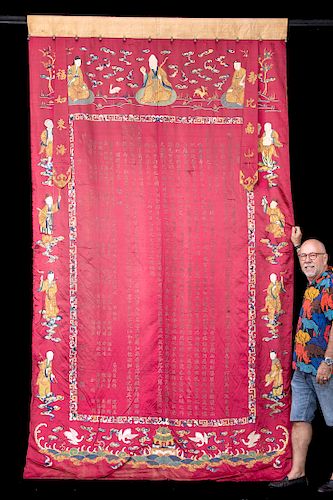18th C. Chinese Silk Tapestry w/ Taoist Imagery & Text
Lot 140a
About Seller
Artemis Gallery
686 S Taylor Ave, Ste 106
Louisville, CO 80027
United States
Selling antiquities, ancient and ethnographic art online since 1993, Artemis Gallery specializes in Classical Antiquities (Egyptian, Greek, Roman, Near Eastern), Asian, Pre-Columbian, African / Tribal / Oceanographic art. Our extensive inventory includes pottery, stone, metal, wood, glass and textil...Read more
Categories
Estimate:
$4,000 - $6,000
Absentee vs Live bid
Two ways to bid:
- Leave a max absentee bid and the platform will bid on your behalf up to your maximum bid during the live auction.
- Bid live during the auction and your bids will be submitted real-time to the auctioneer.
Bid Increments
| Price | Bid Increment |
|---|---|
| $0 | $25 |
| $300 | $50 |
| $1,000 | $100 |
| $2,000 | $250 |
| $5,000 | $500 |
| $10,000 | $1,000 |
| $20,000 | $2,500 |
| $50,000 | $5,000 |
| $100,000 | $10,000 |
| $200,000 | $20,000 |
About Auction
By Artemis Gallery
Sep 26, 2019
Set Reminder
2019-09-26 10:00:00
2019-09-26 10:00:00
America/New_York
Bidsquare
Bidsquare : Exceptional Day 1: Antiquities & Asian Art
https://www.bidsquare.com/auctions/artemis-gallery/exceptional-day-1-antiquities-asian-art-4437
Day 1 of an important 2-day auction featuring exceptional, museum-worthy examples of Egyptian, Greek, Etruscan, Roman, Viking, Russian, Near Eastern, as well as Asian Art from China, Japan, Thailand, Vietnam, Burma and India. Artemis Gallery info@artemisgallery.com
Day 1 of an important 2-day auction featuring exceptional, museum-worthy examples of Egyptian, Greek, Etruscan, Roman, Viking, Russian, Near Eastern, as well as Asian Art from China, Japan, Thailand, Vietnam, Burma and India. Artemis Gallery info@artemisgallery.com
- Lot Description
East Asia, China, ca. late 18th to early 19th century CE. A very large Chinese silk tapestry of a beautiful apple red color with elaborate embroidery (including gold threads). The central panel features a long inscription comprised of numerous rows of characters. This is surrounded by a border of floral blossoms intertwined with geometric elements in green, blue, cream, and gold hues. Surrounding this is a marvelous pictorial border that includes sages, Buddhas, and various divinities floating upon celestial clouds along the top and sides. Along the bottom register is a central sacred tower upon a sacred mountain emerging from the waters with marvelous white cranes carrying counting sticks in their beaks, and flying toward the central pavilion by the sea. (See below for the meaning of this imagery.) The back of this textile is lined with woven gold raw silk. There are metal hooks at the top for suspension, and lovely sashes embroidered with gold Chinese characters for securing when rolled. Size: 126" L x 69" W (320 cm x 175.3 cm)
The curators of a RISD (Rhode Island School of Design) exhibition entitled, "Land of the Immortals: Chinese Taoist Robes and Textiles" (January 13, 2012 - April 22, 2012) explained in their description of a silk Chinese chair cover with similar iconography that this scene refers to "a tale of Taoist sages who counted their age in terms of epochs, not years, and would add a counting stick to a pile to mark each epoch of man. The pavilion represents a Taoist paradise ..." They also provided the following informative introduction to Taoism in their exhibition text, "Taoism, China’s primary indigenous religion and philosophy of life, took shape in the late pre-imperial period (5th to 3rd centuries BCE) and remains influential in Chinese culture today. With origins rooted in earlier nature cults and health practices, Taoism is concerned with both the position of humanity in the cosmos and the attainment of longevity and immortality, physical or otherwise. The focus of Taoism is the Tao (dao). Translated literally, Tao means 'the way'; by extension it may be interpreted as 'the principle' that orders the cosmos. But since the Tao is by definition not meant to be explained, any explanation is misleading. Words cannot match the Tao. The Daodejing, the sacred text of Taoism, begins with the statement, 'the Tao that can be discussed is not the eternal Tao.' Over the centuries practitioners have nonetheless developed a complex symbolic language that gives concrete form to the metaphysical abstractions of the religion's tenets. Whether performing Grand Rituals or one of a variety of private rituals to improve the health of individuals or to exorcise evil spirits, Taoist priests (daoshi) garbed in ceremonial robes appear as one with the cosmos and therefore as powerful spiritual intermediaries acting on the part of their community."
Provenance: private J.H. collection, Beaverton, Oregon, USA
All items legal to buy/sell under U.S. Statute covering cultural patrimony Code 2600, CHAPTER 14, and are guaranteed to be as described or your money back.
A Certificate of Authenticity will accompany all winning bids.
We ship worldwide and handle all shipping in-house for your convenience.
#149588Imagery and inscription are still strong as is the coloration of the silk and embroidery. Expected areas of fraying and tears to the peripheries and some smaller areas on the body of the textile. Some loose and missing threads. Stains to the bottom section (front and back) and a few to the body of the textile.Condition
- Shipping Info
-
All shipping is handled in-house for your convenience. Your invoice from Artemis Gallery will include shipping calculation instructions. If in doubt, please inquire BEFORE bidding for estimated shipping costs for individual items.
-
- Buyer's Premium



 EUR
EUR CAD
CAD AUD
AUD GBP
GBP MXN
MXN HKD
HKD CNY
CNY MYR
MYR SEK
SEK SGD
SGD CHF
CHF THB
THB
















